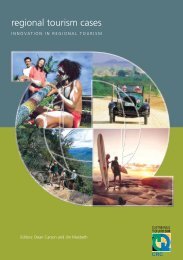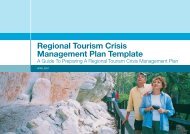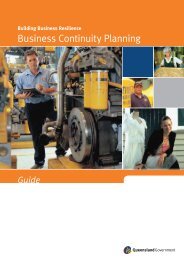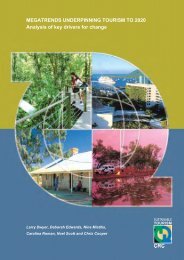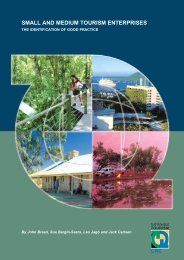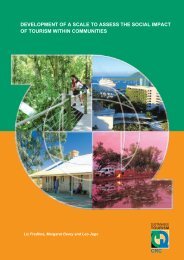Tourism Risk Management - Sustainable Tourism Online
Tourism Risk Management - Sustainable Tourism Online
Tourism Risk Management - Sustainable Tourism Online
Create successful ePaper yourself
Turn your PDF publications into a flip-book with our unique Google optimized e-Paper software.
Example of Elements at <strong>Risk</strong> for a Destination<br />
Sources of risk<br />
Elements at <strong>Risk</strong><br />
(hazards) people environment utilities infrastructure<br />
Tsunami <br />
Epidemic x x<br />
Earthquake <br />
Crime against visitors x x x<br />
Riot x <br />
4. Identify the risk relationship. Review each hazard and the elements at risk and identify if there is a<br />
relationship between them. If so, establish the reason for the relationship.<br />
Develop risk statements for each of the relationships identified. Examples:<br />
• There is a risk that flooding within the town will inundate the X visitor hotel.<br />
• There is a risk that in the event of bad weather there could be an aircraft crash with loss of<br />
many lives including visitors.<br />
These risk statements will be used as a tool for analysis and evaluation.<br />
Source of risk Element at risk Relationship (example)<br />
Flood Visitor hotel Inappropriate siting of building on known flood<br />
plain.<br />
Aircraft crash People, infrastructure Inadequate all-weather navigation aids at<br />
airport.<br />
STEP 3 – Analyse <strong>Risk</strong>s<br />
The purpose of analysing risks is to develop an understanding of the risks the destination is facing.<br />
This understanding will assist in the decision-making on which risks need to be treated and in<br />
identifying the best risk treatment strategies to apply. The step includes analysing the likelihood and<br />
consequences of risks, and also the existing control measures.<br />
1. Identify existing control measures and assess their effectiveness in minimizing likelihood and<br />
consequences.<br />
Examples of existing control measures for flood might include:<br />
• Flood plain management systems;<br />
• Evacuation plans;<br />
• Warning systems;<br />
• Emergency services units trained and equipped for flood rescue tasks;<br />
• Municipal response and recovery plans;<br />
• Annual exercises (tests) of plans and personnel; and<br />
• Public education program.<br />
2. Establish forms of qualitative and quantitative analysis.<br />
28 <strong>Tourism</strong> <strong>Risk</strong> <strong>Management</strong> – An Authoritative Guide to Managing Crises in <strong>Tourism</strong>



